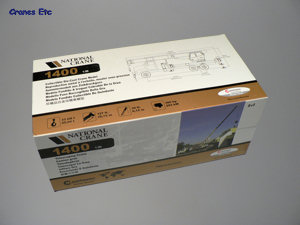 | | National Crane box. | 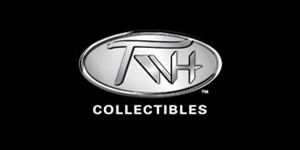 | 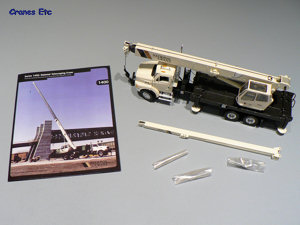 | | All the parts out of the box. |  | | Stowing the extension jib. | 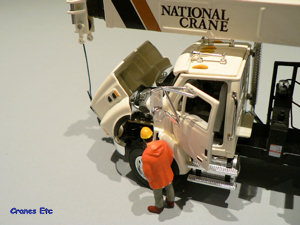 | | Opening cab door and hood. | 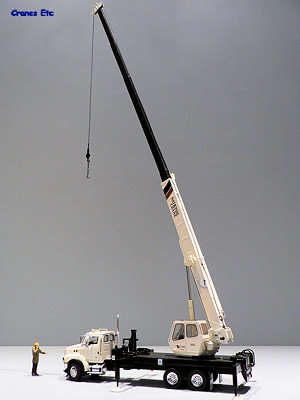 | | The boom partially extended. | 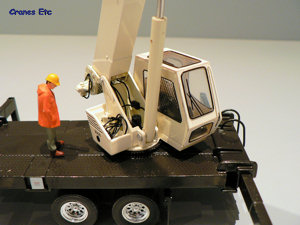 | | Cabling and hoses around the cab. |  | | Boom fitted with the extension jib. |
| The National Crane Company originally started in 1945 and is now a division of the Manitowoc Crane Group. It is the leading producer of commercial truck-mounted boom trucks in the US.
The National 1400 Telescoping Crane is a 30 tonne (33 US ton) capacity crane which can lift to a maximum height of 39m (127ft) on the main boom, with a further extension jib which can add 9m (30ft). This model has the crane mounted on a Sterling truck.
Packaging
The box consists of a picture sleeve that has a photo of the real machine and some technical data. The sleeve covers a pair of expanded polystyrene trays and the model is well packed within. The review model had no defects or missing parts.
A small but detailed product guide brochure is included which gives information about the real crane. It does not describe the model however, and some instructions would have been helpful to a novice collector to describe how the extension jib should be attached to the boom during transport, for example.
Detail
Underneath, the model has some detail with plastic prop shafts and simple engine details. The wheel hubs are detailed and the rubber tyres are treaded albeit with an unusual pattern. A set of mud flaps are modelled behind the rear wheels, although they are plastic.
On the front bumper a stabiliser unit is permanently attached. The front of the hood has headlights although without lenses, and the driving cab has windscreen wipers and plastic door mirrors, with lights and air horns on the roof. Treaded steps provide access to each side of the cab and behind each of these is a detailed fuel tank. A well scaled grab handle is alongside each cab door. The cab doors do not have 'glass' which makes them easy to open but the model would probably look better with the glass in. Inside the cab the model is well detailed with foot pedals and instruments visible. Under the hood is a detailed engine.
Behind the cab is a chromed exhaust stack and after this is a tank with hydraulic lines and some warning signs which are illegible. A plastic frame is attached to the tank. The carrier deck has a textured surface and it contains the outrigger beams which are metal, as are the pads. At the rear there is a simple painted light cluster with some nice ladder handrails.
The crane cab has windscreen wipers and metal grab rails and the interior detail is fairly basic. Within the crane body there is plenty of hydraulic hose detail and the slewing motor is modelled. At the back of the boom the winch is detailed complete with more hoses. The grille which encases the winch is false as it is modelled by a transfer rather than a photo etched piece. A boom angle indicator is provided on each side of the boom and there is a plastic cable drum on one side. The boom is a 5 stage telescope and all parts are metal and the pulleys in the boom head appear plastic.
The hook is metal, and a simple extension jib is provided with the model.
Features
The front wheels steer although they work in a 'notched' fashion rather than being smoothly variable. At the extreme of the lock the wheels are fouled inside the wheel arch and so the model does not roll well when turning.
The cab doors open as does the hood, which tilts forward partially until it is stopped by the front mounted outrigger. This outrigger does not function and it is not removable from the bumper which is a pity. The other outriggers are fully working with extending beams and pads which screw down.
The crane rotates well and the boom elevates, and the boom angle indicators work which is a nice feature. The hydraulic cylinder can be pinned at the maximum angle to hold the pose but the review model cylinder was stiff enough anyway. The boom telescopes and relies on friction to maintain extension. The extension jib can be pinned to the side of the boom for transport and steel pins are also used to fix it to the boom head when required.
The winch turns freely but so much so that it cannot hold any load at all, so collectors will have to be inventive to find a way to jam the winch if a pose holding a load is desired.
Quality
The model is quite detailed and there is a relatively frugal use of plastic. Overall the quality of manufacture of the review model was not to the best of modern standards with glue stains and marks in a few places although these are not really significant enough to detract from the look of the model.
The paintwork is good and the graphics are satisfactory although some of the smaller ones are not particularly distinct.
Price
The model is relatively expensive compared to some of its peers.
Overall
All things considered this is a pleasing model of a relatively unusual sector of the model crane world. There are a number of aspects which can be improved in terms of detail, quality and the operating features.
Overall however, the model is recommended to the crane collector.
Footnotes
The model appeared at the Nuremberg Toy Fair in 2005 and was made in a run of 3000 models.
|
| |
| 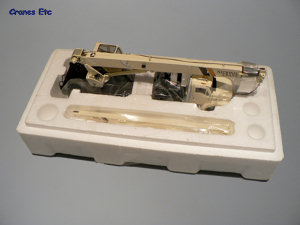 | | Inside the box. | 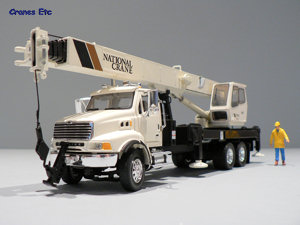 | | The Sterling cab. | 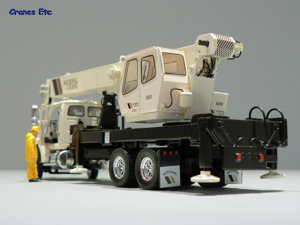 | | Plastic mud flaps at the back. | 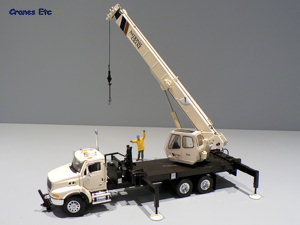 | | Ready for action. | 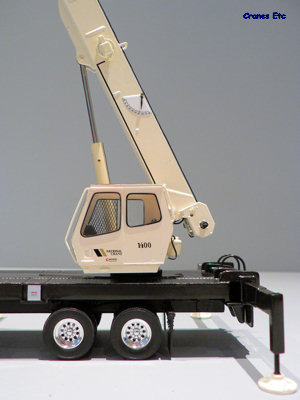 | | Working boom angle indicator and protected glass on the cab. | 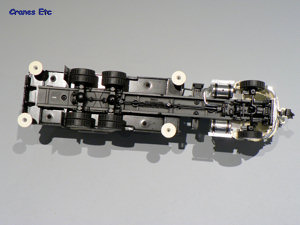 | | Underside view. |  | 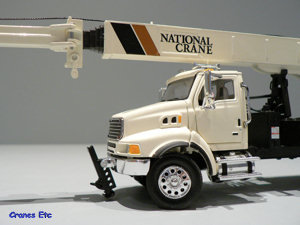 | | Fly jib fitted, and stabiliser at the front. |
|

